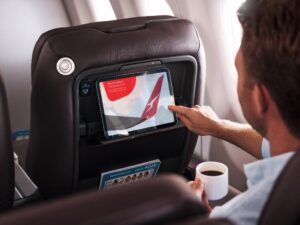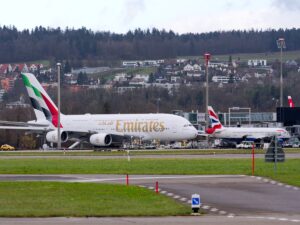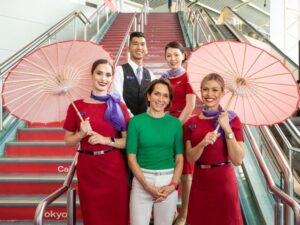
Virgin Australia will stop flying from Cairns to Tokyo’s Haneda Airport in February 2025, citing low demand from Japanese travellers. Virgin’s last Cairns-Haneda flight will depart on 23 February 2025.
The airline will also reduce the frequency of services on this route from September 2024 until February 2025, with flights running only 4-6 days per week instead of daily.
“Our international network continues to be a central part of our strategy. Withdrawing from Cairns-Tokyo services was a tough decision, but unfortunately the recovery of inbound visitors from Japan is significantly below forecast and therefore operating our own service to Tokyo is no longer commercially viable,” Virgin Australia Chief Transformation and Strategy Officer Alistair Hartley said.
“We know this is disappointing news and we are sorry for the impact this decision will have on those guests booked to travel with us from 24 February 2025.”
Virgin’s Velocity Frequent Flyer program will continue to partner with All Nippon Airways (ANA), which flies twice daily from Sydney to Haneda and seasonally from Perth to Narita. But Virgin will not proactively rebook impacted customers onto ANA flights – instead offering them a refund.
Virgin says there are only around 2,000 customers booked to travel between Cairns and Tokyo after 25 February 2025. On one hand, this means the impact isn’t too great. On the other hand, with such low forward bookings, it’s perhaps little wonder Virgin has pulled the plug.
Contents
Virgin Australia fought hard for Haneda Airport slots
Although Virgin launched Cairns-Haneda flights in June 2023, the history of this route goes a lot further back.
In 2019, two new pairs of daytime slots became available to Australian airlines at Tokyo’s Haneda Airport. Valuable slots at this popular airport are very limited, and both Qantas and Virgin bid for them. Ultimately, the International Air Services Commission (IASC) awarded Qantas and Virgin one daily Haneda slot each.
Virgin Australia had planned to use this slot to launch a daily Airbus A330 service from Brisbane to Tokyo in March 2020. Obviously, this never happened due to the onset of the COVID-19 pandemic. (Qantas also did not launch its planned new service to Haneda, instead grounding its entire international operation.)
The slots remained on hold for several years. Eventually Virgin had to either “use them or lose them”, but it no longer had any aircraft capable of operating Brisbane-Tokyo as it had axed its entire wide-body fleet in 2020. With limited other options that would allow it to retain its slots, Virgin launched the Cairns-Haneda route last year.
Operational challenges
Virgin currently uses a Boeing 737-8 MAX for its Cairns-Tokyo route, but initially had to launch it using Boeing 737-700s due to delivery delays with the MAX.
The Boeing 737 can (just) make the seven-hour flight from Cairns to Tokyo, but not without operational challenges. It’s a long flight for a narrow-body aircraft. With limited usable diversion airports available over the North Pacific Ocean, some flights may need to be weight-restricted during unfavourable weather conditions.
In practice, this hasn’t often been a problem because many flights have been far from fully booked anyway. Unfortunately, that’s also part of the reason why Virgin now says this route is “commercially unsustainable” – even with financial support from the Queensland government.

Poor load factors
AFF members who’ve taken the Cairns-Tokyo flight have reported that they weren’t full. But does the data back this up?
We checked the load factors on each of the five airlines operating direct flights between Australia and Japan between July 2023 and April 2024. July 2023 was the first full month that Virgin flew to Japan, and April 2024 is the last month for which BITRE data is currently available.
As you can see from the chart below, Virgin Australia has consistently underperformed compared to other airlines – even with far fewer seats to sell:

On average, since launching services to Tokyo, Virgin’s flights have been just under two-thirds full. That’s compared to average load factors of 88% on Japan Airlines and 86% on Qantas over the same period.
Why has Virgin struggled to fill this flight?
One of the challenges Virgin faces on this route is that it only offers same-day connections to Tokyo through Cairns from three Australian cities – Brisbane, Sydney and Melbourne. In the other direction, passengers flying from Tokyo to Sydney need to wait almost six hours in Cairns – an airport where Virgin no longer even has a lounge.

There’s also the obvious challenge of Virgin trying to compete using a Boeing 737 that has no lie-flat Business Class seating (just 8 Business recliner seats), no seatback entertainment screens, and no food included on Economy tickets. All other airlines flying between Australia and Japan use more comfortable wide-body planes.

If Virgin Australia could capture a large number of Japanese tourists coming to Cairns, it could have made the route work. ANA (and now also Qatar Airways) do codeshare on the route as well. But Virgin says that inbound demand from Japan is lower than expected. One reason, it says, is the depreciation of the Japanese Yen.
When the route initially launched, it was not actually possible to buy a ticket from Japan to Australia on the Virgin Australia website. That may not have helped either, but has since been resolved.
That said, outbound demand from Australia to Japan is through the roof. The number of Australian tourists visiting Japan last year was already back at pre-COVID levels, and this year the number is even higher.
What happens to Virgin Australia’s Haneda slot?
In reality, Cairns-Haneda was unlikely to ever be a huge money-maker for Virgin Australia. But the airline was determined to hold onto its valuable airport slots ahead of a potential IPO or sale. It seems Virgin has now decided the cost of continuing to run these flights outweighs the value of the slots.
The IASC will most likely now offer Virgin’s slot to other Australian airlines. Realistically, Qantas will be the only airline to bid for it – and will almost certainly get it.
This will most likely see Qantas switching either its daily Melbourne-Narita or Brisbane-Narita service to Haneda Airport from late February 2025. That would leave just one Qantas service operating into Narita Airport.
















































































